United Arab Emirates Armed Forces
The United Arab Emirates Armed Forces (Arabic: القوات المسلحة لدولة الإمارات العربية المتحدة Al-Quwwāt al-Musallaḥa li-Dawlat al-ʾImārāt al-ʿArabīyyah al-Muttaḥidah) are the armed forces of the United Arab Emirates and have primary responsibility for the defence of all seven emirates. They consists of approximately 100,000 personnel, and are headquartered in Abu Dhabi, United Arab Emirates.
| United Arab Emirates Armed Forces | |
|---|---|
| القوات المسلحة لدولة الإمارات العربية المتحدة | |
 Seal of the United Arab Emirates Armed Forces | |
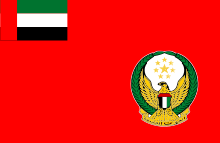 Flag of the United Arab Emirates Armed Forces | |
| Founded | 1951 |
| Current form | 1971 |
| Service branches | |
| Website | Ministry of Defence |
| Leadership | |
| Commander-in-Chief | Khalifa bin Zayed Al Nahyan |
| Deputy Commander-in-Chief | Crown Prince Mohammed bin Zayed Al Nahyan |
| Minister of Defence | Vice President Mohammed bin Rashid Al Maktoum |
| Chief of staff | Lt. Gen. Hamad Mohammed Thani Al Rumaithi |
| Manpower | |
| Military age | 18 years |
| Available for military service | 3,658,577, age 15–49 |
| Fit for military service | 3,072,125, age 15–49 |
| Reaching military age annually | 51,85 |
| Active personnel | Approximately 100,000[1] (ranked 42nd) |
| Reserve personnel | 180,000 (Almost) |
| Expenditures | |
| Budget | US$22.755 billion (2014) |
| Percent of GDP | 5.6% |
| Industry | |
| Domestic suppliers | Edge Group |
| Foreign suppliers | |
| Related articles | |
| History | The Invasion of Hamasa Dhofar Rebellion Lebanese Civil War Gulf War(1990-1991) Kosovo Force United Nations Operation in Somalia II War in Afghanistan (2001–present) Libyan Civil War (2011) Libyan Civil War (2014–present) International military intervention against ISIL Yemeni Civil War (2015–2019) Sinai insurgency |
| Ranks | Military ranks of United Arab Emirates |
The United Arab Emirates Armed Forces were formed in 1951 as the historic Trucial Oman Scouts, a long symbol of public order in Eastern Arabia. Since their formation, the armed forces have been deployed in various military and humanitarian missions. As a result of their active and effective military role despite their small active personnel, the United Arab Emirates Armed Forces are commonly nicknamed "Little Sparta" by United States Armed Forces General and former US defense secretary James Mattis.[4]
History
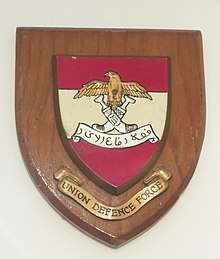
Prior to the union of the emirates, different tribal confederations formed the de facto military force which was dominant in the area now known as the United Arab Emirates. The Bani Yas and Al Qawasim were the most significant of those tribal confederations. The Al Qawasim were a major maritime force in the region, which prompted the British Royal Navy to organize several campaigns, such as Persian Gulf campaign of 1809 and Persian Gulf campaign of 1819 and the deployment of ground forces in Ras Al Khaimah to control the trade routes the Al Qawasim dominated. With the signing of the 1820 General Maritime Treaty between the British and the tribal sheikhs and the commencement of the British Residency of the Persian Gulf, the British Empire with the assistance of Sheikh Khalid III bin Muhammad al-Qasimi endeavored to form a unified paramilitary force based in Sharjah to suppress the slave trade and prevent tribal conflicts. The paramilitary force was named the Trucial Oman Levies.[5]
The current United Arab Emirates military was formed from the historical Trucial Oman Levies which was established on 11 May 1951. The Trucial Oman Levies, which were renamed the Trucial Oman Scouts in 1956, were considered a long symbol of public order in Eastern Arabia and were commanded by British officers from the British Empire. The Trucial Oman Scouts were turned over to the United Arab Emirates as the nucleus of its defense forces in 1971 with the formation of the UAE and were absorbed into the newly formed united military called the Union Defence Force (UDF). The Union Defence Force was established officially as the military of the United Arab Emirates on 27 December 1971 from a directive issued by the UAE's founding father and first president, Sheikh Zayed bin Sultan Al Nahyan.[6]
As the Union Defence Force, every emirate was responsible for the equipment and training of its own defence forces. In the event of an attack on any one of the seven emirates, the Union Defence Force would be mobilized from every emirate to defend the emirate under attack. In 1974 the name was changed to the Federal Armed Forces. On 6 May 1976, the Federal Armed Forces were unified as a single body. This was considered a historic event and a large milestone in the military of the United Arab Emirates. May 6 is celebrated annually as the Military Union Day. As a result of the union of forces, the number of personnel formed a brigade and was referred to as the Yarmouk Brigade.[6]
After the union of the armed forces in 1976, the Yarmouk Brigade was officially renamed the United Arab Emirates Armed Forces. The three largest emirates defence forces which originally formed the Federal Armed Forces, Abu Dhabi Defence Force, Dubai Defence Force, and Ras Al Khaimah Mobile Force, were converted into three major military bases/zones for the United Arab Emirates Armed Forces. In 1976 the official UAE Armed Forces insignia, uniform, military academies, air force, and naval force were established and the military General Headquarters (GHQ) was formed in the capital Abu Dhabi.[6]
Although initially small in number, the UAE armed forces have grown significantly over the years and are presently equipped with some of the most modern weapon systems, purchased from a variety of outside countries, mainly France, the US and the UK. Most officers are graduates of the United Kingdom's Royal Military Academy at Sandhurst, with others having attended the United States Military Academy at West Point, the Royal Military College, Duntroon, and St Cyr, the military academy of France.
The United Arab Emirates Armed Forces participated in multiple conflicts, mostly in the Middle East. During 1990–1991, the Armed Forces participated in Gulf War. 6 Emirati soldiers lost their lives in liberating Kuwait. The UAE Armed Forces were also deployed in Eastern Europe and joined NATO's Kosovo Force peacekeeping mission undertaking aid missions to thousands of fleeing refugees on the Albanian border. This was the first time Emirati troops uniform was switched to the woodland camouflage compared to their regular home desert camouflage.[7] The UAE Armed Forces also participated in peacekeeping missions in Lebanon and Somalia. The UAE Armed Forces is also the only Arab country to commit troops to maintain security and participate in humanitarian aid missions to Afghanistan. The Emirati special Forces, the Presidential Guards, were deployed to maintain security in War in Afghanistan against the Taliban. In March 2011, the UAE joined the enforcement of the no-fly-zone over Libya by sending six F-16 and six Mirage 2000 multi-role fighter aircraft[8] and in 2015 the UAE joined the Saudi-led coaltion intervention in Yemen by sending 30 UAEAF F16 Desert Falcons to Yemen. The intervention was followed by Emirati ground troops deployment in Southern Yemen mainly focusing on targeting terrorist cells such as the Al-Qaeda in the Arabian Peninsula and the Islamic State.
The UAE introduced a mandatory military conscription for adult males in 2014 of 16 months to expand its reserve force.[9] The date of the first death in the line of duty of an Emirati soldier was on 30 November 1971 during the Seizure of Abu Musa and the Greater and Lesser Tunbs as is celebrated annually as the Commemoration Day. The highest loss of life in the history of the UAE military occurred on Friday 4 September 2015, in which 52 soldiers were killed in Marib area of central Yemen by a Tochka missile which targeted a weapons cache and caused a large explosion.[10] All the names of Emirati soldiers who died in the line of duty are inscribed in the UAE Armed Forces memorial, the Oasis of Dignity, in the capital Abu Dhabi.
Organization
.jpg)
There is one unified military structure across the UAE. The military forces consist of an Army, Navy, Airforce, and the Presidential Guard (PG) Special forces.
Military branches
UAE Army
As part of the military of the United Arab Emirates, the Army (called Land Forces in Arabic) is responsible for land and ground based operations.
- Medical Corps form part of the UAE Army and are responsible for military medical support to the rest of the UAE Armed Forces.
UAE Air Force
The United Arab Emirates Air Force has about 4,000 personnel.[11] The air force agreed in 1999 to purchase 80 US F-16 multirole fighter aircraft. Other equipment includes 60 Mirage 2000s, British Hawk aircraft, and French helicopters. The air defense has a Hawk missile program for which the United States has been training. The UAE has taken delivery of two of five Triad I-Hawk batteries.
- United Arab Emirates Air Defence Force is responsible for civil defense aircraft and protecting the country's airspace.
UAE Navy
The United Arab Emirates Navy consists of more than 2,000 personnel and 72 vessels.
- United Arab Emirates Marines – The UAE maintained a small battalion-sized Marine force called the UAE Marines until 2011 when it was merged into the UAE-PG.
- United Arab Emirates Coast Guard – The United Arab Emirates Coast Guard is the official coast guard agency of the United Arab Emirates and is primarily responsible for the protection of the UAE's coastline through regulation of maritime laws, maintenance of seamarks, border control, anti-smuggling operations and other services.
UAE Presidential Guard
The United Arab Emirates Presidential Guard (UAE-PG) was formed in 2011 by merging the Amiri Guard, Special Operations Command, and the Marine Battalion from the UAE Navy. UAE requested training support be provide by the U.S. Marine Corps (USMC).[12] The U.S. State Department approved a foreign military sales (FMS) Training Case for UAE-PG in October 2011. Marine Corps Training Mission UAE (MCTM-UAE) operates under chief of mission authority as a Title 22 FMS training case.[13] While the UAE military no longer has a Marine unit, USMC has designated the UAE-PG as its service counterpart. The PG is designated as the elite and most specialized force of the UAE military and is commanded by Mike Hindmarsh.
Paramilitary forces
- Federal Police Force
Former Emirate forces
Four Emirates maintained their own forces prior to the unification of the defence forces. Three were theoretically merged into the Union Defence Force in 1976, but in practice remained under emirate control and procured weapons separately for some time after.
- Abu Dhabi Defence Force – Formed in 1965 by order of Sheikh Shakhbut Al Nahyan and commanded by Major Edward 'Tug' Wilson.[14] The officer corps were mainly British and Jordanian. Although not initially an operational force of consequence,[14] by 1975 it had grown to 15,000 men with two squadrons of Dassault Mirage III fighters and Dassault Mirage 5 attack aircraft, a squadron of Hawker Hunter fighter-bombers, 135 armoured vehicles, Rapier and Crotale missiles, Aérospatiale Alouette III and Aérospatiale Gazelle helicopters, and a sea defence wing of four fast patrol boats.[15] The ADDF became the Western Command of the UDF in 1976.
- Dubai Defence Force – Formed in 1971, by 1975 the DDF had 3,000 men with Ferret and Saladin armoured cars.[15] It later expanded to 20,000 men in one infantry brigade group, Aermacchi MB-326 ground attack aircraft and MBB Bo 105 helicopters. The DDF became the Central Command of the UDF in 1996.
- Ras al-Khaimah Mobile Force – Formed in 1969, it initially had 300 men with Ferret and Saladin armoured cars, organised into one armored squadron and two infantry squadrons. It eventually expanded to 9,000 men. It became the Northern Command of the UDF in 1996.
In addition, the Sharjah National Guard was formed in 1972. It was essentially a paramilitary force of 500–600 men with Shorland armoured cars. It merged with the Federal Police in 1976.[15]
Deployments
.jpg)

It dispatched an infantry battalion to the United Nations UNOSOM II force in Somalia in 1993, it sent the 35th Mechanised Infantry Battalion to Kosovo, and sent a regiment to Kuwait during the Iraq War. In addition, it helps protect the Persian Gulf and Strait of Hormuz. It is a leading partner in the campaign against terrorism, providing assistance in the military, diplomatic, and financial arenas. The UAE military provides humanitarian assistance to Iraq.
Gulf War
The UAE sent forces to assist Kuwait during the 1990–1991 Gulf War where several hundred UAE troops participated in the conflict as part of the GCC Peninsula Shield force that advanced into Kuwait City. The US 363rd Tactical Fighter Wing (Provisional) operated from Al Dhafra Air Base in Abu Dhabi, and US ships operated out of UAE ports.[16] The UAE air force also carried out strikes against Iraqi forces. The UAE Armed Forces participated in the coalition with an army battalion along with a squadron of Dassault Mirage 5 and Mirage 2000.[16] 6 Emirati troops were killed in action.[17]
United Nations Operation in Somalia II
The UAE Armed Forces participated in UNOSOM II which was an intervention launched in March 1993 until March 1995, and committed resources to the United Nations mission.[18][19]
Lebanon
UAE Military field engineers arrived in Lebanon at 8 September 2007 in Beirut for clearing areas of south Lebanon from mines and cluster bombs.
War in Afghanistan (2001–present)
A UAE deployment in Afghanistan started in 2007.
Saudi led intervention in Yemen
In 2015, the UAE participated in the Saudi Arabian-led intervention in Yemen to influence the outcome of the Yemeni Civil War (2015–present).[20] On 4 September 2015, 52 UAE soldiers (together with 10 Saudi and 5 Bahraini soldiers) were killed when a Houthi missile hit an ammunition dump at a military base in Ma'rib Governorate,[21] marking the highest death toll on the battlefield in the country's history.[22]
In 2016 Battle of Mukalla, the United Arab Emirates Armed Forces liberated the port of Mukalla from AQAP forces in 36 hours after being held by AQAP for more than a year with the US defense secretary James Mattis calling the UAE led operation a model for American troops.[23] However, in 2018, the Associated Press in a report mentioned that the UAE struck deals with AQAP militants by recruiting them against fighting the Houthis and providing them with money. The report continued to state that the United States was aware of Al-Qaeda joining ranks with the UAE and has held off drone strikes against Al-Qaeda.[24] UAE Brigadier General Musallam Al Rashidi responded to the report by stating that Al Qaeda cannot be reasoned with in the first place stating that "There’s no point in negotiating with these guys."[25] The UAE military stated that accusations of allowing AQAP to leave with cash contradicts their primary objective of depriving AQAP of its financial strength.[26] The notion of Al Qaeda joining ranks with UAE Armed Forces and the US holding off drone strikes against Al Qaeda has been thoroughly denied by The Pentagon with Colonel Robert Manning, spokesperson of the Pentagon, calling the news source "patently false".[27] According to The Independent, AQAP activity on social media as well as the number of reported attacks conducted by them has decreased since the Emirati intervention.[26]
On 30 April 2018 the UAE armed forces, as part of the ongoing Saudi-led intervention in Yemen, landed troops on the island of Socotra.[28] The Independent newspaper reported that the UAE has politically annexed the island and built a communications network, as well as conducted census and provided Socotra residents with free healthcare and work permits in Abu Dhabi.[29] Two weeks later on 14 May, Saudi troops were also deployed to the archipelago and a deal was brokered between the United Arab Emirates and Yemen for a joint military training exercise and the return of administrative control of Socotra's airport and seaport to Yemen.[30][31][32]
In June 2018, a major offensive was carried out by the UAE-led troops in Hodeidah.[33]
In June 2019, the UAE announced a partial withdrawal of its troops by reducing Emirati armed forces fighting in Yemen. A senior official from the UAE called the move a "strategic" redeployment.[34] According to a Reuters report, the gulf nation ordered the withdrawal of its troops following security concerns, after tensions with Iran. The UAE stated that it is shifting its focus from Houthi rebels to ISIS and al-Qaeda in Yemen.[35]
Armed equipment
Military Expansion
.jpg)
In 1989, UAE purchased Scud-B ballistic missiles from North Korea.[36] The UAE went on an expansion drive in 1995, which began with the 1992–93 acquisition of 436 Leclerc tanks and 415 BMP-3 armoured vehicles. It had learned from the Iranian experiences with having a single supplier for its military and has diversified its arms purchases, purchasing weaponry mainly from Russia, the United States, the UK, Ukraine, France, Italy and Germany. It has also taken care to invest in the systems it has purchased and standardise them according to NATO/GCC Specifications.
The equipment purchases was also followed by a programme to increase manpower numbers and Emiratisation programme for the Armed forces. Presently (2005) almost all pilots in the UAE Air Force are UAE nationals, with the restriction of non-nationals to certain positions in the instruction and maintenance divisions of the airforce. More nationals are being trained to fill these ranks, with programmes such as the Technical Trainee Project underway to try to fill the technical jobs in the country.
There has also been a qualitative shift in the Personnel in the armed services, with expert instruction being brought in from around the world, refinement of local military training institutions and the increase in standards across the armed forces. In 2008, the UAE bought MIM-104 Patriot missiles[37] and related radar, support services for the Patriot systems. There has been work concurrently on the Hawk systems, the Patriots predecessor, currently in use by the UAE.
In the last days of 2011, during a war scare with Iran over the Straits of Hormuz, the UAE announced a purchase of US$3.48 billion worth of American missile systems: 2 radar systems, 96 missiles, spare parts and training.[37] The UAE was the first country to acquire the Terminal High Altitude Area Defense System (THAAD). A contract worth $1.96 billion was agreed for Lockheed Martin Corp to supply two Thaad anti-missile batteries.[38]
In November 2019, South Africa blocked supply of arms to United Arab Emirates, Oman, Algeria, and Saudi Arabia following a dispute in the inspection clause of its agreement. According to a report by Reuters, the UAE and the other mentioned countries refused to allow officials from South Africa to inspect their facilities. The dispute arose as the UAE and the other countries refused the inspections, stating it violated their sovereignty. According to the industry, the inspection row puts business at risk and could cause the loss of up to 9,000 jobs at defense firms and supporting industries in South Africa. UAE began firing trials with China, India, and Serbia to replace the South African RDM as preferred supplier of ammunition.[39]
Military industry
The UAE has begun to produce a greater amount of military equipment in a bid to reduce foreign dependence and help with national industrialisation. The Abu Dhabi Shipbuilding company (ADSB) produces a range of ships and are a prime contractor in the Baynunah Programme, a programme to design develop and produce 5–6 corvettes customised for operation in the shallow waters of the Persian Gulf. It has also produced and is producing ammunition, military transport vehicles and unmanned aerial vehicles.
In 2007, the first small arm ever produced in UAE, the Caracal pistol, was introduced at IDEX. It became the official sidearm of the UAE armed forces and security forces. The National Guard of Bahrain adopted it shortly thereafter. Jordan ordered an unspecified number of pistol in April, 2008 during SOFEX, the Special Forces Exhibition held in Jordan. UAE and Algeria established on 17 November 2008 a joint committee in order to test the Caracal pistol for further adoption by Algeria.
A joint venture agreement was signed in Abu Dhabi on 28 November 2007 between Tawazun Holding LLC, an investment company established by the Offset Program Bureau (OPB), Al-Jaber Trading Establishment, part of Al-Jaber Group, and Rheinmetall Munitions Systems, to set up the Al-Burkan munition factory at the Zayed Military City in Abu Dhabi.
The OPB signed four Memorandums of Understanding with leading companies from Europe and Singapore at the Paris Eurosatory 2008 defence exhibition on June 20, Rheinmetall Group and Diehl Defence Holding of Germany, Singapore Technologies Engineering (ST Engg), and Thales of France.
Tawazun has also partnered with Saab on radar development.[40]
Military expenditures
- 1999: $2,100,000,000 (1.8% of gross domestic product)
- 2000: $2,600,000,000 (0.8% of gross domestic product)
- 2005: $3,800,000,000 (1.0% of gross domestic product)
- 2010: $10,000,000,000
Gallery
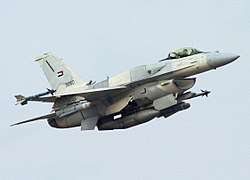 United Arab Emirates F-16 Block 60 taking off after taxiing out of the Lockheed Martin plant in Fort Worth, TX (NAS Fort Worth JRB)
United Arab Emirates F-16 Block 60 taking off after taxiing out of the Lockheed Martin plant in Fort Worth, TX (NAS Fort Worth JRB)- Several Emirati Air Force Mirage 2000s over Afghanistan in 2008
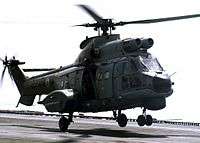 A United Arab Emirates Navy Super Puma helicopter
A United Arab Emirates Navy Super Puma helicopter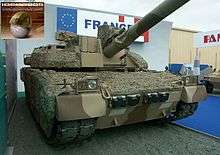 Emirati Leclerc tank
Emirati Leclerc tank
References
- IISS 2018, pp. 367
- "United Arab Emirates - Defense". export.org. 23 April 2018. Archived from the original on 12 November 2018. Retrieved 11 November 2018.
- "Emirati Army - Modernization". Globalsecurity.org. Archived from the original on 12 November 2018. Retrieved 11 November 2018.
- "In the UAE, the United States has a quiet, potent ally nicknamed 'Little Sparta'". The Washington Post. Archived from the original on 18 August 2018. Retrieved 15 September 2018.
- de Butts, Freddie (1995). Now the Dust Has Settled. Tabb House. ISBN 1873951132.
- "توحيد القوات المسلحة أعظم قرارات دولة الاتحاد". Al Bayan. 1 January 2015.
- "Special Report: The day Emirati troops came to help war-torn Kosovo". The National. 29 July 2019.
- "Libya no-fly zone: Coalition firepower". BBC News. Archived from the original on 9 December 2014. Retrieved 25 December 2014.
- "UAE extends compulsory military service to 16 months". Reuters. 8 July 2018.
- "UAE, Bahrain say 50 soldiers killed in Yemen attack". Reuters. 4 September 2015. Retrieved 17 September 2015.
- "United Arab Emirates". U.S. Department of State. Retrieved 25 December 2014.
- UAE Presidential Guard Command https://www.globalsecurity.org/military/world/gulf/uae-pg.htm. Retrieved 8 May 2019. Missing or empty
|title=(help) - MARADMIN 620/12, PERSONNEL SOURCING GUIDANCE IN SUPPORT OF MARINE CORPS TRAINING MISSION - UNITED ARAB EMIRATES (MCTM- UAE) https://www.marines.mil/News/Messages/Messages-Display/Article/895109/personnel-sourcing-guidance-in-support-of-marine-corps-training-mission-united/. Retrieved 8 May 2019. Missing or empty
|title=(help) - De Butts, Freddie (1995). Now The Dust Has Settled. Tabb House. p. 193. ISBN 1873951132.
- H. Richard Sindelar III; John E Peterson (1988). Crosscurrents in the Gulf: Arab Regional and Global Interests. Routledge. p. 213.
- Brigadier General Ibrahim Al-Nakhi. The Gulf war: UAE Participation in that War (PDF). Archived (PDF) from the original on 30 October 2018. Retrieved 11 August 2018.
- "The Role of the United Arab Emirates in the Iran-Iraq War and the Persian Gulf War". Country-data.com. Archived from the original on 1 May 2011. Retrieved 1 February 2011.
- "UNITED NATIONS OPERATION IN SOMALIA II". UN.org. 21 March 1997. Archived from the original on 6 October 2018. Retrieved 22 December 2018.
- Salama, Samira (3 January 2015). "Priming UAE's military into a force to reckon with". Gulf News. Archived from the original on 22 December 2018. Retrieved 22 December 2018.
- "Tributes paid to 45 Emirati heroes martyred in Yemen". gulfnews.com. Archived from the original on 5 September 2015. Retrieved 5 September 2015.
- "Yemen crisis: UAE launches fresh Yemen attacks". BBC.com. 5 September 2015. Archived from the original on 7 September 2015. Retrieved 6 September 2015.
- Staff Reporter. "UAE salutes 45 soldiers martyred in Yemen". Khaleej Times. Archived from the original on 6 September 2015. Retrieved 5 September 2015.
- "US-UAE counter-terrorism operations on the rise in Yemen". The National. 15 March 2018. Archived from the original on 11 April 2019. Retrieved 11 April 2019.
- "Inside the UAE's war on al-Qaeda in Yemen". The Independent. Archived from the original on 15 August 2018. Retrieved 15 August 2018.
- "UAE responds to AP report on deals with al-Qaida in Yemen". Associated Press. 13 August 2018. Archived from the original on 11 April 2019. Retrieved 11 April 2019.
- Trew, Bel (15 August 2018). "Inside the UAE's war on al-Qaeda in Yemen". The Independent. Archived from the original on 11 April 2019. Retrieved 11 April 2019.
- "Pentagon denies reports of U.S. allies bribing, recruiting al Qaeda fighters in Yemen". Washington Times. Archived from the original on 29 August 2018. Retrieved 29 August 2018.
- "As Saudi Arabia and the UAE struggle for control of Socotra, Yemen's island paradise may just swap one occupation for another". The Independent. 21 May 2018. Archived from the original on 11 April 2019. Retrieved 11 April 2019.
- "Socotra island: The Unesco-protected 'Jewel of Arabia' vanishing amid Yemen's civil war". The Independent. 2 May 2018. Archived from the original on 11 April 2019. Retrieved 11 April 2019.
- "Yemen PM: Crisis over UAE deployment to Socotra over". Aljazeera.com. Archived from the original on 18 May 2018. Retrieved 11 April 2019.
- "Yemen, UAE Agree on Deal Over Socotra". Al Bawaba. 14 May 2018. Archived from the original on 16 May 2018. Retrieved 11 April 2019.
- "As Saudi Arabia and the UAE struggle for control of Socotra, Yemen's island paradise may just swap one occupation for another". The Independent. 21 May 2018. Archived from the original on 11 April 2019. Retrieved 11 April 2019.
- "Yemen separatist leader says Hodeidah offensive will not stop". Reuters. Archived from the original on 20 September 2018. Retrieved 20 September 2018.
- "UAE partially withdrawing from Yemen, says official". CNN. Retrieved 8 July 2019.
- "Exclusive: UAE scales down military presence in Yemen as Gulf tensions flare". Reuters. Retrieved 28 June 2019.
- Diplomat, Samuel Ramani , The. "Why Did the UAE Purchase Weapons From North Korea?". Archived from the original on 9 August 2017. Retrieved 9 August 2017.
- "Gulf States Requesting ABM-Capable Systems". Defense Industry Daily. 2 October 2014. Archived from the original on 16 October 2014. Retrieved 25 December 2014.
- "US bolsters UAE's missile defense in major arms deal". Archived from the original on 25 December 2014. Retrieved 25 December 2014.
- "RPT-South Africa blocks arms sales to Saudi and UAE in inspection row". Reuters. Retrieved 25 November 2019.
- Yee, April. "Abu Dhabi's Tawazun putting new eyes on the skies with radar deal". The National. Retrieved 25 December 2014.
Further reading
- Britain, the UAE, and the defence of the Gulf revisited, International Affairs (journal), September 2013
- Victor Gervais, Du Petrole a l'armee: Strategies de construction de l'Etat aux Emirats Arabes Unis, Paris: IRSEM, 2012
- The Evolution of the Armed Forces of the United Arab Emirates by Athol Yates https://www.amazon.co.uk/Evolution-Armed-Forces-United-Emirates/dp/1912866005
External links
| Wikimedia Commons has media related to Military of the United Arab Emirates. |
![]()
